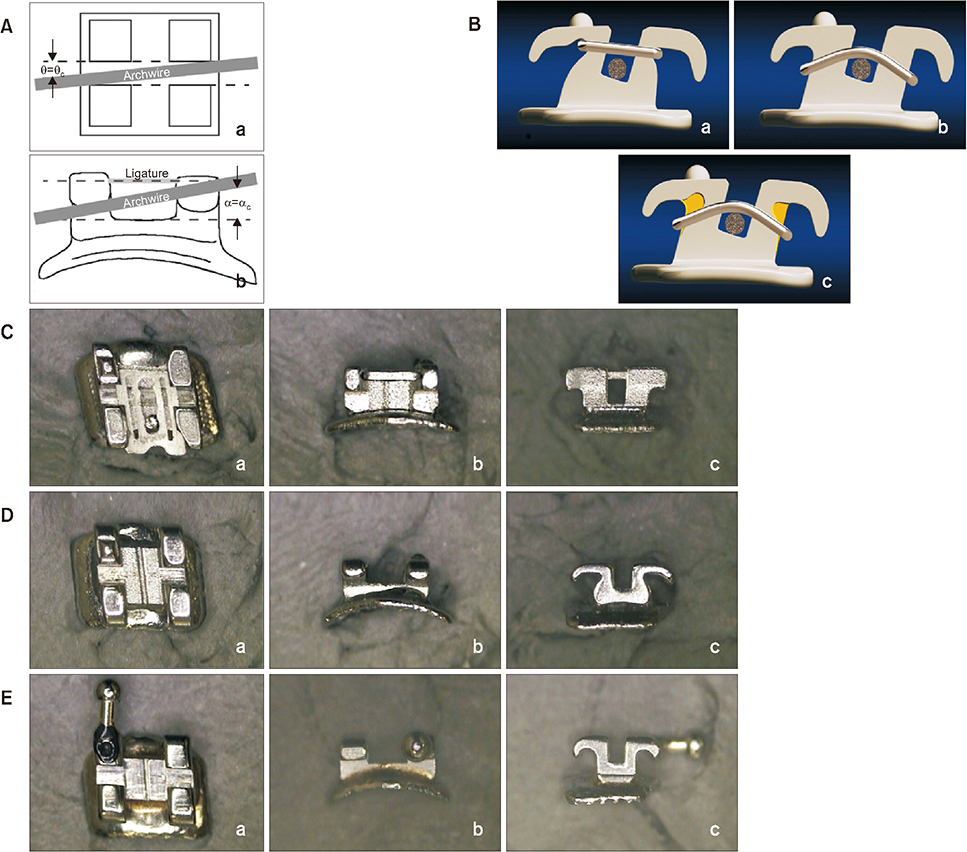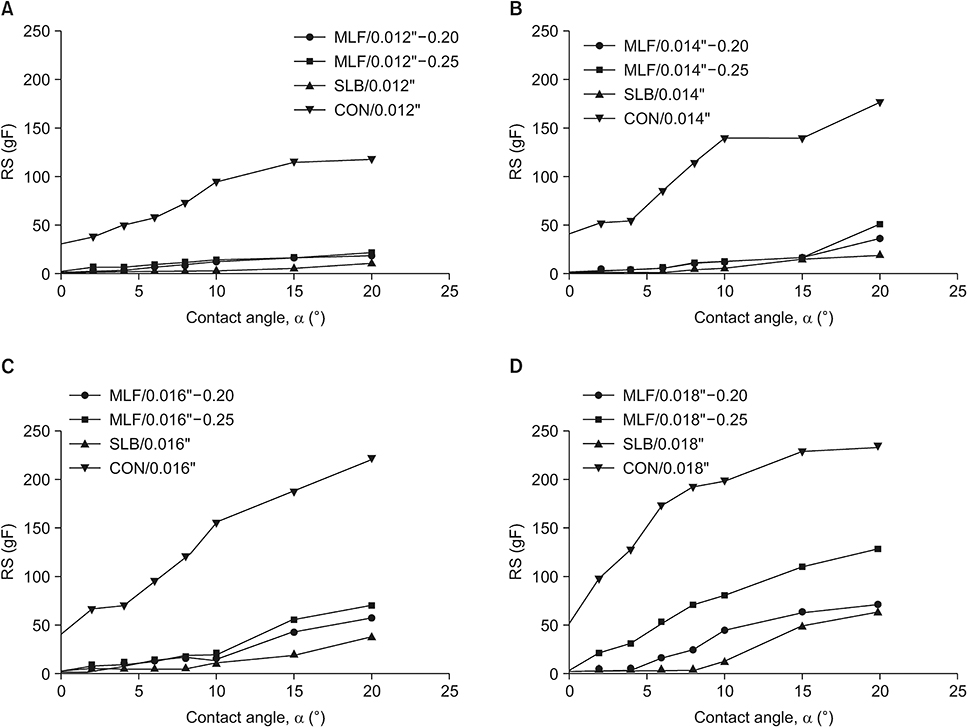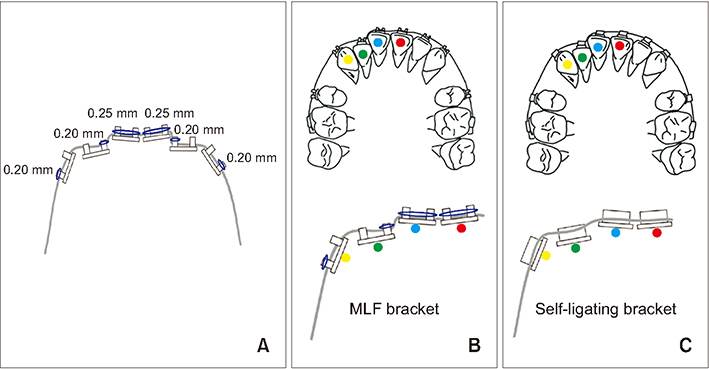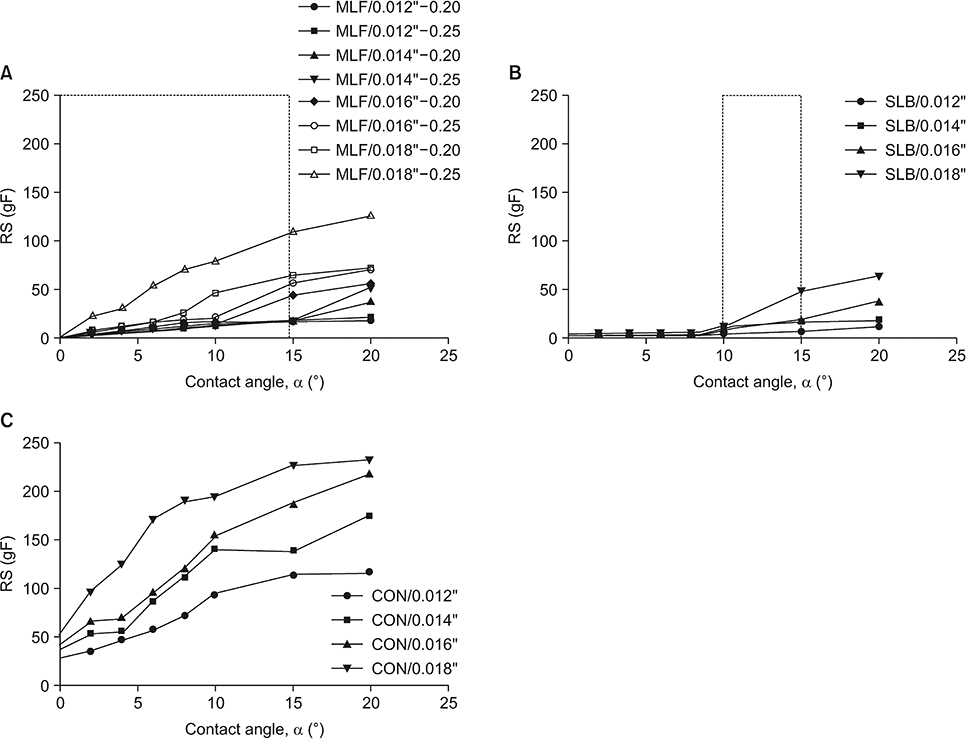Korean J Orthod.
2019 Jan;49(1):21-31. 10.4041/kjod.2019.49.1.21.
Effect of different combinations of bracket, archwire and ligature on resistance to sliding and axial rotational control during the first stage of orthodontic treatment: An in-vitro study
- Affiliations
-
- 1Department of Orthodontics, School and Hospital of Stomatology, Peking University, Beijing, China. tmxuortho@163.com
- KMID: 2431077
- DOI: http://doi.org/10.4041/kjod.2019.49.1.21
Abstract
OBJECTIVE
This study was performed to explore the effect of different bracket, archwire, and ligature combinations on resistance to sliding (RS) and rotational control in first-order angulation.
METHODS
Three types of brackets (multi-level low friction [MLF], self-ligating, and conventional brackets) coupled with four nickel-titanium archwires (0.012, 0.014, 0.016, and 0.018-inch diameter) and two stainless steel ligatures (0.20 and 0.25 mm) were tested in different first-order angulations (0°, 2°, 4°, 6°, 8°, 10°, 15°, 20°) by using an Instron universal mechanical machine in the dry state at room temperature. RS value was evaluated and compared by one-way ANOVA.
RESULTS
Under the same angulation, the RS values showed the following order: conventional brackets > MLF brackets > self-ligating brackets. The RS was the highest for conventional brackets and showed a tendency to increase. The RS for MLF brackets coupled with thinner archwires and ligatures showed a similar tendency as the RS for the self-ligating bracket. In contrast, the RS for MLF brackets coupled with thicker archwires and ligatures increased like that for conventional brackets. MLF brackets showed the greatest range of critical contact angles in first-order angulation.
CONCLUSIONS
The RS in first-order angulation is influenced by bracket design, archwire, and ligature dimension. In comparison with self-ligating and conventional brackets, MLF brackets could express low friction and rotational control with their greater range of critical contact angles.
Keyword
Figure
Reference
-
1. Kusy RP, Whitley JQ. Friction between different wire-bracket configurations and materials. Semin Orthod. 1997; 3:166–177.2. Kusy RP, Whitley JQ. Influence of archwire and bracket dimensions on sliding mechanics: derivations and determinations of the critical contact angles for binding. Eur J Orthod. 1999; 21:199–208.
Article3. Kusy RP, Whitley JQ. Resistance to sliding of orthodontic appliances in the dry and wet states: influence of archwire alloy, interbracket distance, and bracket engagement. J Biomed Mater Res. 2000; 52:797–811.
Article4. Harradine NW. Self-ligating brackets: where are we now? J Orthod. 2003; 30:262–273.
Article5. Chen SS, Greenlee GM, Kim JE, Smith CL, Huang GJ. Systematic review of self-ligating brackets. Am J Orthod Dentofacial Orthop. 2010; 137:726.e1–726.e18. discussion 726-7.
Article6. Fleming PS, Johal A. Self-ligating brackets in orthodontics. A systematic review. Angle Orthod. 2010; 80:575–584.7. Ong E, McCallum H, Griffin MP, Ho C. Efficiency of self-ligating vs conventionally ligated brackets during initial alignment. Am J Orthod Dentofacial Orthop. 2010; 138:138.e1–138.e7. discussion 138-9.
Article8. Miles PG. Smartclip versus conventional twin brackets for initial alignment: is there a difference? Aust Orthod J. 2005; 21:123–127.9. Miles PG, Weyant RJ, Rustveld L. A clinical trial of Damon 2 vs conventional twin brackets during initial alignment. Angle Orthod. 2006; 76:480–485.10. Fleming PS, DiBiase AT, Lee RT. Randomized clinical trial of orthodontic treatment efficiency with self-ligating and conventional fixed orthodontic appliances. Am J Orthod Dentofacial Orthop. 2010; 137:738–742.
Article11. Chen S, Chen G, Xu T. Clinical application of the PASS technique. J Clin Orthod. 2015; 49:508–515.12. Ko CC, Chen S, Zang H. Mechanical properties of various archwires and their clinical application in the PASS system. In : Xu TM, editor. Physiologic Anchorage control: a new orthodontic concept and its clinical application. New York: Springer;2017. p. 71–86.13. Nanda R, Ghosh J. Biomechanical considerations in sliding mechanics. In : Nanda R, editor. Biomechanics in clinical orthodontics. Philadelphia: Saunders;1997. p. 188–217.14. Pizzoni L, Ravnholt G, Melsen B. Frictional forces related to self-ligating brackets. Eur J Orthod. 1998; 20:283–291.
Article15. Rinchuse DJ, Miles PG. Self-ligating brackets: present and future. Am J Orthod Dentofacial Orthop. 2007; 132:216–222.
Article16. Bednar JR, Gruendeman GW. The influence of bracket design on moment production during axial rotation. Am J Orthod Dentofacial Orthop. 1993; 104:254–261.
Article17. Thorstenson GA, Kusy RP. Effect of archwire size and material on the resistance to sliding of self-ligating brackets with second-order angulation in the dry state. Am J Orthod Dentofacial Orthop. 2002; 122:295–305.
Article18. Thorstenson GA, Kusy RP. Comparison of resistance to sliding between different self-ligating brackets with second-order angulation in the dry and saliva states. Am J Orthod Dentofacial Orthop. 2002; 121:472–482.
Article19. Jiang R, Teng F, Du F, Chen H, Xu TM. Drift dentition and low-friction appliance. In : Xu TM, editor. Physiologic Anchorage control: a new orthodontic concept and its clinical application. New York: Springer;2017. p. 103–120.20. Bednar JR, Gruendeman GW, Sandrik JL. A comparative study of frictional forces between orthodontic brackets and arch wires. Am J Orthod Dentofacial Orthop. 1991; 100:513–522.
Article21. Suryawanshi GR, Sundareswaran S, Philip K, Kumar S. In vitro evaluation of different methods of ligation on friction in sliding mechanics. Orthodontics (Chic.). 2013; 14:e102–e109.
Article22. Hain M, Dhopatkar A, Rock P. The effect of ligation method on friction in sliding mechanics. Am J Orthod Dentofacial Orthop. 2003; 123:416–422.
Article23. Yeh CL, Kusnoto B, Viana G, Evans CA, Drummond JL. In-vitro evaluation of frictional resistance between brackets with passive-ligation designs. Am J Orthod Dentofacial Orthop. 2007; 131:704.e11–704.e22.
Article24. Pesce RE, Uribe F, Janakiraman N, Neace WP, Peterson DR, Nanda R. Evaluation of rotational control and forces generated during first-order archwire deflections: a comparison of self-ligating and conventional brackets. Eur J Orthod. 2014; 36:245–254.
Article25. O'Reilly D, Dowling PA, Lagerstrom L, Swartz ML. An ex-vivo investigation into the effect of bracket displacement on the resistance to sliding. Br J Orthod. 1999; 26:219–227.26. Kusy RP. Ongoing innovations in biomechanics and materials for the new millennium. Angle Orthod. 2000; 70:366–376.
- Full Text Links
- Actions
-
Cited
- CITED
-
- Close
- Share
- Similar articles
-
- Comparison of the frictional resistance between orthodontic bracket & archwire
- The comparison of the frictional force by the type and angle of orthodontic bracket and the coated or non-coated feature of archwire
- Comparison of frictional forces between orthodontic brackets and archwires
- Effectiveness of medical coating materials in decreasing friction between orthodontic brackets and archwires
- A comparative study of frictional force in self-ligating brackets according to the bracket-archwire angulation, bracket material, and wire type







